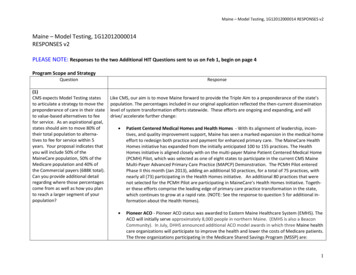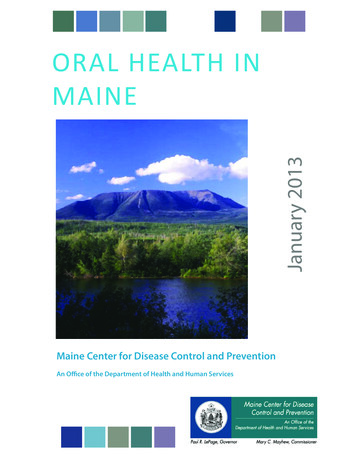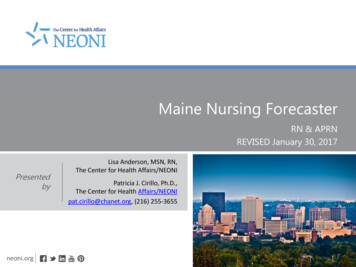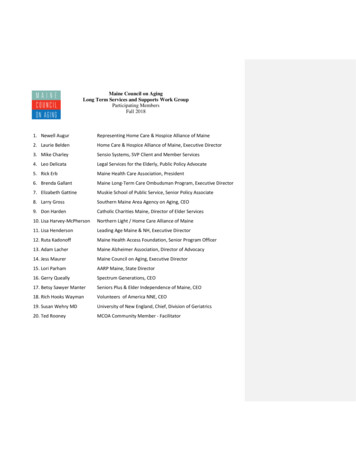
Transcription
Maine – Model Testing, 1G12012000014 RESPONSES v2Maine – Model Testing, 1G12012000014RESPONSES v2PLEASE NOTE: Responses to the two Additional HIT Questions sent to us on Feb 1, begin on page 4Program Scope and StrategyQuestion(1)CMS expects Model Testing statesto articulate a strategy to move thepreponderance of care in their stateto value-based alternatives to feefor service. As an aspirational goal,states should aim to move 80% oftheir total population to alternatives to fee for service within 5years. Your proposal indicates thatyou will include 50% of theMaineCare population, 50% of theMedicare population and 40% ofthe Commercial payers (688K total).Can you provide additional detailregarding where those percentagescome from as well as how you planto reach a larger segment of yourpopulation?ResponseLike CMS, our aim is to move Maine forward to provide the Triple Aim to a preponderance of the state’spopulation. The percentages included in our original application reflected the then-current disseminationlevel of system transformation efforts statewide. These efforts are ongoing and expanding, and willdrive/ accelerate further change:Patient Centered Medical Homes and Health Homes - With its alignment of leadership, incentives, and quality improvement support, Maine has seen a marked expansion in the medical homeeffort to redesign both practice and payment for enhanced primary care. The MaineCare HealthHomes initiative has expanded from the initially anticipated 100 to 155 practices. The HealthHomes initiative is aligned closely with on the multi-payer Maine Patient Centered Medical Home(PCMH) Pilot, which was selected as one of eight states to participate in the current CMS MaineMulti-Payer Advanced Primary Care Practice (MAPCP) Demonstration. The PCMH Pilot enteredPhase II this month (Jan 2013), adding an additional 50 practices, for a total of 75 practices, withnearly all (73) participating in the Health Homes initiative. An additional 80 practices that werenot selected for the PCMH Pilot are participating in MaineCare’s Health Homes Initiative. Together these efforts comprise the leading edge of primary care practice transformation in the state,which continues to grow at a rapid rate. (NOTE: See the response to question 5 for additional information about the Health Homes).Pioneer ACO - Pioneer ACO status was awarded to Eastern Maine Healthcare System (EMHS). TheACO will initially serve approximately 8,000 people in northern Maine. (EMHS is also a BeaconCommunity). In July, DHHS announced additional ACO model awards in which three Maine healthcare organizations will participate to improve the health and lower the costs of Medicare patients.The three organizations participating in the Medicare Shared Savings Program (MSSP) are:1
Maine – Model Testing, 1G12012000014 RESPONSES v2QuestionResponseMaineHealth Accountable Care Organization in Portland, with 1,595 physicians; Central MaineACO in Lewiston, which includes 566 physicians; and Maine Community Accountable Care Organization LLC in Augusta, a collaboration of nine federally qualified health center with 125 physicians.Inclusion of Small Providers in ACOs - Small providers are being included in ACO initiatives, andmore are expected to come on board. Several additional provider groups have expressed their intent to participate since the SIM application was submitted.Move Towards New Payment Models - Self insured purchasers and large employers are collectively moving towards risk based contracts and entering into commercial ACO arrangements withvarious health systems. Maine Health Management Coalition (MHMC) employer members havecollectively committed to move to global payment arrangements with PMPM targets as adequateperformance measures become available and provider and plan capability improves. Severalcommercial ACO contracts have been put in place since the original application and discussionscontinue with several others.The market is accelerating the move of greater numbers of patients into risk based arrangements,including ACOs. Simultaneously large employers are moving to develop networks around PatientCentered Medical Homes, incenting the move to this model of care both within ACOs and amongindependent practices. Most employer members and health plans within MHMC are offering increased payments for medical homes in alignment with public payors and in direct arrangements.Anthem has also announced a statewide initiative to pay significantly enhanced fees to primarycare to support practice transformation and will be working with the MHMC to align measurement and incentives. Recently the City of Portland, working with the Maine Health ManagementCoalition, redesigned their benefit package around a PCMH network. This benefit model is beingshared with other employer members to continue the support for this model and drive the market in this direction. The University of Maine System and others are implementing similar benefitdesign changes to incent employees to move towards medical homes and ACOs. Collectivelythese changes are very likely to impact 80% of patients in the state within 4-5 years.(2)2
Maine – Model Testing, 1G12012000014 RESPONSES v2QuestionPlease provide a one-page operational/phase in schedule for yourvarious populations and programs.(3)Please describe how your programwill interact with other CMMI initiatives and other federally-fundedhealth IT initiatives operating inMaine and who will be responsiblefor coordinating with those otherinitiatives.ResponseAn operational phase-in schedule is attached to this document. During our information call on January30, CMS/CMMI also requested an organizational diagram of the project, showing who is overseeing, howcontractors are integrated, and so forth. That diagram is also attached.The SIM project team is deeply involved in many CMS and Federally Funded Programs across the State,including but not limited to the: Pioneer ACO at Eastern Maine Healthcare System; Bangor Beacon Community; and the CMS Maine Multi-Payer Advanced Primary Care Practice Demonstration.HealthInfoNet is the Statewide Health Information Exchange (HIE) (partnering with the State on Maine’sHIE Cooperative Agreement Program) and Regional Extension Center. In addition as the HIE, HealthInfoNet’s infrastructure is critical to the Bangor Beacon Program, as it supports electronic health record(EHR) interoperability statewide, care management notifications for care managers in the Beacon Program and elsewhere, provides population health monitoring and surveillance tools, and provides aggregate clinical data to support the evaluation efforts of the Beacon Project.HealthInfoNet is partnering with the Center for Integrated Behavioral Health and their Substance Abuseand Mental Health Administration (SAMHSA) and Health Resources and Services Administration (HRSA)cooperative agreement. Under this contractual partnership, HealthInfoNet is one of five organizationsfunded nation-wide to implement health information exchange functions for the behavioral health community. This project supported changes to the HIE architecture to allow for mental health information tobe exchanged while supporting a positive consent (“opt-in”) by patients, for providers and other clinicalstaff using the HIE, to access their sensitive (Mental Health and HIV) in the HIE. To date 25 behavioralhealth organizations across the state have been provide access to HIE tools.In addition to these important grant and contract programs, HealthInfoNet is serving as the clinical dataprovider for the Eastern Maine Healthcare Systems Pioneer ACO as well as the Maine Health Shared Savings ACO efforts. This activity involves a partnership between Eastern Maine, Maine Health, HealthInfoNet and the Northern New England ACO Collaborative (NNEAC). As the statewide HIE, HealthInfoNetcollects discrete clinical data on all patients agnostic of who pays for their care or where that care is delivered. This function allows HealthInfoNet to provide comprehensive clinical data on ACO patients attributed to both these integrated delivery networks (from the ACO facilities as well as from hospitals and pro-3
Maine – Model Testing, 1G12012000014 RESPONSES v2QuestionResponseviders that are not members of the ACO but are seeing attributed patients) to NNEAC who then runs riskanalysis software and provides identification of both financial and clinical high-risk patients and management tools for care managers and providers in the ACOs. NNEAC is working with HealthInfoNet to providethese services to other ACOs emerging across the State.ADDITIONAL HIT QUESTION (1)From CMS on Feb 1, 2013How will you coordinate withother statewide HIT initiatives toaccelerate adoption of healthinformation technology amongproviders?Please specifically addresshow you will reach providers in small practices andbehavioral health providers.Please describe your costallocation plan or methodology for all of the plannedIT system solutions/buildsfunded in part by CMS orany other federal agency.As a core team member of the SIM Application for Maine, HealthInfoNet will be responsible for coordination of HIT efforts. As stated previously, HealthInfoNet is the statewide HIE, Regional Extension Center,Beacon Partner, and is coordinating behavioral health HIT efforts around the state. Each of these existingprograms have a number of sub-project that target the acceleration of HIT adoption and Meaningful Use.The efforts of the Regional Extension Center are focused specifically on targeting providers in small practices both in Maine’s urban and rural areas. Over 1,000 physician providers and 22 Critical Access and Rural Hospitals are currently enrolled in the program and. Over 900 physicians engaged through the RECprogram have implemented an ONC Certified EHR and over 375 of these physicians have met stage 1Meaningful Use. The Regional Extension Center staff will be essential team members of HIT initiative forSIM. The cost for the REC team will be born by the Regional Extension Center cooperative agreement between ONC and HealthInfoNet.HealthInfoNet also has been coordinating behavioral health HIT projects across the state for the pastyear. This project (as described above) incorporates over 120 behavioral health and primary carestatewide. This project was funded in 2012 through a contract between HealthInfoNet and the NationalCenter for Community Behavioral Health. That project is now over and there is no duplication or overlapof funds between that project and what is being proposed for SIM.SIM resources are requested for specific projects that do not overlap with other federally funded activities including:Providing real-time notifications from the HIE to MaineCare and health system care managerswhen MaineCare members are admitted or discharged from inpatient and emergency room settings;Providing behavioral health EHR incentives (for providers and organizations that do not otherwisequalify for Meaningful Use)4
Maine – Model Testing, 1G12012000014 RESPONSES v2QuestionResponseProviding HIE technical support in interfacing behavioral health EHRs to the HIEProviding a clinical dashboard for MaineCare from the HIE enabling MaineCare to clinically monitorMaineCare patient health care utilization and outcomes from the population-level down to the patient level.Providing all Maine patients (starting with MaineCare)with access to their statewide EHR record,aggregated by the HIE and made available through certified EHR portals provided by the health systems and provider organizations across the state.Funds for HIT projects will be allocated to HealthInfoNet and the Maine Health Management Coalitionbased on negotiated contracts for services with the State of Maine. Specific deliverables will be identifiedand funds will be paid on a deliverable basis. All contractors will be required to adhere to Federal Regulations on allowable costs, non-duplication of funds across programs, capital asset allocation, regulationson use of “open-source” and non-proprietary software, and Federal audit and reporting requirements.ADDITIONAL HIT QUESTION (2)From CMS on Feb 1, 2013Please describe any impactthis project will have on theMMIS, and how the MMISwill be used to support theproject, including whetherthere will be a need to addany new system functionalityor enhancements to existingsystem functionality to support the effort. Please describe all MMIS claims, recipient, provider or other MMISdata and the specific MMISbusiness processes the stateThe Office of MaineCare Services (OMS) is currently utilizing its MMIS to track and manage the providerand member data necessary to support its PCCM implementation and to pay out Management Fees. Additionally, the MMIS system is currently being enhanced to support the implementation of Health Homes.These enhancements will provide a framework for any additional system enhancements necessary tosupport Accountable Communities. OMS expects to capture and manage the provider, member, andclaims data necessary to support Accountable Communities within its MMIS application. In order to accomplish this, the following steps are required:A detailed analysis of the provider, member, and claims data requirements needed by external partners to perform actuarial and financial analysis to support this initiative.Once the data requirements have been determined, modifications to the MMIS may be necessary toproperly associate providers, practice sites, and/or service locations to the appropriate AccountableCommunity.Modifications to the MMIS and/or the eligibility system may also be required to correctly associateMaineCare members to the ACO that they are assigned to.Provider and/or Member portal applications may need to be enhanced to facilitate the capture andmanagement of the specific data elements required to administer Accountable Communities.5
Maine – Model Testing, 1G12012000014 RESPONSES v2Questionwill utilize in support of thiseffort.ResponseThe MMIS financial application and interface may need to be enhanced to support new payment orreimbursement requirements associated with Accountable Communities.Additional data extracts, reports, and/or publication files will need to be developed or enhancedwithin the MMIS to provide external stakeholders with the data necessary to assess outcomes, perform actuarial analysis, assess quality, and track costs and benefits.What are the estimatedplanning and implementationtimelines for the neededchanges to MMIS, if any, and The required changes to the MMIS have not yet been fully documented and assessed. As such, specifichow will these timelinesplanning and implementation timelines have not been developed.dovetail with the SIM project?(4)Please describe how your programwill interact with Maine’s plan toalign care for beneficiaries duallyeligible for Medicare and Medicaid.We initially submitted a letter of intent to the CMS Medicare - Medicaid Coordination Office stating ourintent to pursue the managed Fee For Service financial alignment model to integrate care for MedicareMedicaid enrollees through the inclusion of “Dual Eligibles” in its planned Accountable Communities andHealth Homes models. Post-submission, the Coordination Office made the decision that duals engaged inthe Pioneer or Medicare Shared Savings Program ACOs would need to be excluded from the initiative.Due to the potential for significant overlap between duals in MaineCare’s planned Accountable Communities Initiative and the Pioneer and MSSP ACOs, the Department decided that the ROI for the intensive application and stakeholder engagement process would be lacking. However, we continue to target the dual population through our Accountable Communities and Health Homes Initiative to promote care coordination and management for this high needs population.In addition to these MaineCare efforts, duals are also served by Medicare through the CMS Multi-payerAdvanced Primary Care Practice demonstration in Maine’s multi-payer PCMH Pilot . MaineCare does notprovide Health Homes payments to duals served by practices under the MAPCP demonstration in order toavoid duplication of payment.(5)Clarify the relationship between thePCMH and the ACOs. Do you envision that the entire state will becomposed of several ACOs, eachWe do envision that the state will be composed of multiple ACOs, each made up of several Patient Centered Medical Homes (PCMHs)/ Health Homes. As will be the case in all rural states, there will be practices that will not be part of an ACO, and we are trying to bring them into the Health Homes initiative.6
Maine – Model Testing, 1G12012000014 RESPONSES v2QuestionResponsemade up of several PCMHs? Whatif a PCMH is not part of an ACO?Who provides the care management fee for the PCMH? What levelof payment are you planning to offer?PCMHs/ Health Homes build the foundation for ACOs in Maine. Multi-payer investment in support forthese medical home models ensure the provision of evidence-based, preventive care, patient engagement, care coordination and management, all activities that will aid ACOs to achieve their goals of improved health and improved care for lower costs. MaineCare’s participation in the state’s Multi-PayerPatient Centered Medical Home Pilot through the Health Homes Initiative (implemented January 2013)enables a statewide reach of these efforts through the enhanced 90/10 match under Section 2703 of theAffordable Care Act. In addition to almost 75 practices participating in the multi-payer PCMH Pilot,MaineCare is funding an additional 80 practices through the Health Homes Initative alone that do notcurrently have multi-payer support. MaineCare is providing 12 per member per month (PMPM) forMaineCare members that meet the Health Home chronic conditions eligibility criteria. In addition, Community Care Teams that partner with the Health Home practices to serve the 5% highest need patients inthose practices receive 129.50 PMPM to provide intensive care management services to those individuals. Maine is developing a second stage of its Health Homes Initiative to serve individuals with SeriousMental Illness. In this second stage, medical home practices will partner with organizations with behavioral health expertise.PCMHs and Health Homes are not required to be part of ACOs. There are many smaller and/or independent practices and behavioral health organizations that may not have the capacity to engage in an ACO orrisk0bearing arrangement, but that can contribute greatly to delivery system reform, improved patientoutcomes and decreased avoidable costs.It is one of our aims under SIM to foster and encourage increased participation by commercial payers tosupport those Health Homes that are NOT part of the multi-payer PCMH. In fact, at least one commercialpayer (Anthem) is currently involved in doing this, in recognition that multi-payer involvement is theemerging alignment model in the state. The first step in changing the payment model is providing caremanagement. If Health Homes are engaged in ACOs, as we expect many to be, then we will expect payment to be linked to quality and cost measuresAdditionally, most plan sponsors and self insured employers in the Coalition have committed to at least 3PMPM for patient centered medical homes whether practices are owned by health systems or independent. Some large employers have entered into contracts paying up to 12PMPM for medical homepractices. Several are also encouraging and/or directing their health plans to direct additional resources7
Maine – Model Testing, 1G12012000014 RESPONSES v2QuestionResponseto practice and community based care management rather than plan based telephonic care management.Currently some plans receive over 5PMPM for telephonic care management services that are resourcesemployers and providers are encouraging plans to more effectively integrated into the practices.In some cases employers are seeking direct and/or preferred arrangements with primary care based systems as alternatives to hospital based ACOs and are seeing lower costs. These arrangements, which encourage primary care practices to direct care to high quality and low cost tertiary and specialty care, arenot unlike the Alternative Quality Contract model in Massachusetts and are of interest to several employers committed to a primary care based system. It remains too early to determine which model will prevailin Maine or if both will coexist, but in either model the PCMH is foundational to improving populationhealth and reducing costs. The Pathways to Excellence program (of Maine Health Management Coalition)will enable purchasers and patients to select medical home practices within health systems or independent through its public reporting of ‘Advanced Primary Care’.(6)While we understand that you arestill in the planning process for yourinitiative, can you provide us with apreliminary perspective on the following issues related to the designof your ACO model?What formula will you use forshared savings? Will providerstake on one-sided or twosided (downside risk) risk?Will your model include atransition to population basedpayments?How will you support providers as they transition to accountable care arrangements?How will you ensure that ACOsMaineCare Accountable Communities Initiative: - Providers able to achieve savings for an attributedpopulation in comparison to a baseline projected target per member per month (PMPM) may receiveshared savings payments, the amount of which is dependent on their performance on specified qualitybenchmarks. To date, MaineCare plans to offer two models: one with no downside risk and a maximumof 50% shared savings in order to attract, smaller, more diverse organizations; and a second with downside risk transitioned in over three years and a maximum of 60% shared savings. Maine’s Governor andDepartment of Health & Human Services are very interested in pursuing population-based payments, particularly through an 1115 waiver outside of the 1915(b) managed care regulations in order to maintain aprovider-based approach to localized care management.Commercial Market -The large employer members of the Maine Health Management Coalition (MHMC)have publicly acknowledged their commitment to moving to global contracts within 5 years and haveshared this directly with the majority of health systems in the state. Several have announced plans to tieron a system or ACO basis, incenting employees to use medical homes and ACOs with strong quality, patient experience and cost scores. Downside risk is expected and some systems have moved past sharedsavings to arrangements with PMPM targets. Several have also entered into direct arrangements for bundled services in orthopedics as some provider groups have begun to offer bundled pricing with a warran-8
Maine – Model Testing, 1G12012000014 RESPONSES v2Questionenter into other payment arrangements such that theyshare risk for quality and financial performance for a majority of their patients by acertain time?Responsety. Health plans have been unable to operationalize payment arrangements beyond FFS but have committed to developing that capacity within 3 years.Transitioning to ACO Model - Along with the transition to population and value-based payments, we willprovide support for the transition to ACO models through expansion of our statewide learning community, beginning with a focus on supporting primary care transformation as the foundation for ACO efforts.We will build on our previous experience to offer statewide learning collaboratives to support adoption ofa set of Patient Centered Medical Home (PCMH) “Core Expectations”, supporting practice transformationto a patient-centered, high-value model of care. These learning collaboratives will provide structuredlearning opportunities and data feedback to identify and spread best practices among primary care practices, with a particular focus on building relationships, improving efficiencies and improving experience ofcare. As part of this effort, PCMH practices will also receive support to link with their hospital and othercommunity partners to reduce avoidable Emergency Department utilization, hospitalizations, and readmissions.State LeversQuestionResponse(7)Please outline your strategy for using your state’s executive, regulatory and legislative authorities to aligncommercial payers and providersfor health delivery system transformation.Discussions are underway with the Commissioner of DHHS, who sits on the Governor's cabinet and hasacted in the capacity of the Governor's healthcare advisor on recommendations for healthcare reformlegislation to achieve meaningful change in healthcare costs. Maine’s growth in healthcare expendituresfrom 1991 – 2009 was 7.4% compared to 6.5% for the U.S. average. Health care expenditures per capitafor 2009 (most recent data available form Kaiser) were 8,521 compared to 6,815 a 20% difference.)Ideas being discussed are:Establish a statewide health care cost growth goal for the health care industry in Maine, peggedat an amount no greater than the growth in the state’s overall economy.Set a Healthcare Cost Reduction Goal for MaineCare in SFY14 and 15. Equivalent to Savings Identified by the MaineCare Redesign Taskforce for Care Management.Create a Global Medicaid Spending Cap and Provide the Commissioner of DHHS with the Power to9
Maine – Model Testing, 1G12012000014 RESPONSES v2QuestionResponseEnforce That Cap.All new expenditures must be analyzed to assess their impact on both cost and quality. The globalspending cap means savings for state taxpayers. The cap represents the core of the state’s budgetneutrality argument for a future 1115 Medicaid waiver to be.Enhance Transparency and Accountability in the Health Care MarketplaceEstablish a new “Cost and Market Impact Review” to examine changes in the health care industryand the impact of these changes on cost, quality, and market competitiveness. The findings of thisreview inform CON process.Develop a process to track price variation among different health care providers over time and establishes a Special Commission to determine and quantify the acceptable and unacceptable factors contributing to price variation among providers.Leverage Maine’s Health Information SystemRequire all licensed hospitals and medical providers that are eligible and receive CMS meaningfuluse incentive payments to participate in the state designated health information exchange.Require the state designated health information exchange make 100% of its clinical data to available to qualified entities for purposes of healthcare management i.e. to support accountable careorganizations and quality improvement, and public health.Require the Maine Health Data Organization (MHDO) to develop public and performance reporting of providers using e-measures as they become available.Use the state certificate of need (CON) process as a mechanism to assure linkage to healthcarecost reduction targetsSpecific to Pricing - There is also the potential development of a Governor’s bill that would address concerns related to pricing of healthcare services that could be modeled on the Massachusetts law. Mechanisms at the Commissioner’s disposal include CON approval linked to costs of care trend. MaineCare iscurrently working with CMS to develop a State Plan Amendment under the Integrated Care Model 9ICM)guidance released in July 2012 to develop its Accountable Communities Initiative, a shared savings Medicaid ACO model. Over the course of this grant, Maine’s Governor and Department of Health & HumanServices are very interested in pursuing population-based payments, particularly through an 1115 waiveroutside of the 1915(b) managed care regulations in order to maintain a provider-based approach to localized care management.10
Maine – Model Testing, 1G12012000014 RESPONSES v2QuestionResponseSpecific to Health Homes - Maine is also pursuing a second Health Homes State Plan Amendment andrulemaking to institute “Stage B” Health Home model to serve adults with Serious Mental Illness and children with Serious Emotional Disturbance.Specific to Health Information Technology - Since its inception, HealthInfoNet and its multi-stakeholderpublic/private stakeholders have carefully assessed the federal and state laws that would facilitate andimpede clinical health information sharing. To address these legal issues, HealthInfoNet has workedclosely with its Consumer Advisory Committee (including consumers, consumer advocacy organizationssuch as the Maine Civil Liberties Union, literacy specialist, and government) to implement HIE policies atthe organizational level that would permit safe and secure sharing of essential information. These policies include a formal consent policy allowing consumers to opt-out of participating in the exchange. Theconsent forms are available online and are provided to consumers by the participating provider organizations. Consumers can send the signed forms to HealthInfoNet electronically, or by mail or fax. In additionHealthInfoNet maintains a toll-free number for consumers to call with questions. Once HealthInfoNet receives the signed opt-out forms, the consumer’s clinical information is deleted from the data repository.Only consumer demographic information is maintained to assure that HealthInfoNet does not collect andstore any future clinical information on consumers that have opted out.Partnering with the HealthInfoNet, the State Government and other health stakeholders around the statecollaborated to further strengthen HealthInfoNet’s commitment and responsibilities to educate consumers on their rights and options for participation in the exchange and to assure proper security and privacyprotections are in place, with the enactment in June, 2011, of LD1337, “An Act to Ensure Patient Privacyand Control with Regard to Health Information Exchange”. This statute requires healthcare practitionersand facilities partic
program have implemented an ONC Certified EHR and over 375 of these physicians have met stage 1 Meaningful Use. The Regional Extension Center staff will be essential team members of HIT initiative for SIM. The cost for the REC team will be born by the Regional Extension Center cooperative agreement be-tween ONC and HealthInfoNet.










